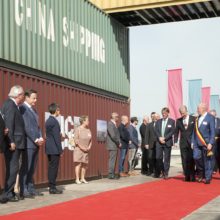
King Filip, minister Ben Weyts, the chairman of the European Investment Bank Werner Hoyer and alderman Marc Van Peel of Antwerp, in charge of port affairs, have solemnly inaugurated the huge Kieldrecht Lock. This biggest lock in the world has a price tag of €382 million and ensures smooth access to the Waasland harbour. The Kieldrecht Lock strengthens the competitiveness of the Port of Antwerp and will attract new economic activity to Flanders.
The Grande Lagos of shipping company Grimaldi was granted the honour of entering the brand-new Kieldrecht Lock as the very first ship. With a length of 500 m, a width of 68 m and an operational depth (TAW) of some 17.80 m, the biggest lock in the world can accommodate the largest seagoing vessels. The Maritieme Toegang (maritime access) of the Department of Mobility and Public Works, together with the Port Authority of Antwerp and a building consortium, had been building the Kieldrecht Lock for almost 5 years, making the project one of the biggest Flemish works in the past few years.
The Kieldrecht Lock enables smooth access to the Waasland harbour in Antwerp. Until then, the smaller Kallo Lock was the only gate to the Waasland harbour. This meant that the ships could have to wait for more than three hours. Any problem with the Kallo Lock could paralyse the whole Waasland harbour. The Kieldrecht Lock now enables a second, bigger, more upstream access to the docks on the left bank of the Scheldt river. In future, the ships can expect faster and smoother access to the harbour.
The government of Flanders and the Port Authority of Antwerp had together invested €382 million to realise the Kieldrecht Lock. Flanders had assumed 75% of the investment costs. The Flemish Minister of Mobility, Ben Weyts, talked about an investment with a leverage effect which will benefit the whole of Flanders: “The Kieldrecht Lock will give shipping companies an additional reason to choose Flanders. We will strengthen the international competitiveness of the Port of Antwerp and attract new economic activity to our region. Our Flemish ports can offer the whole world fast, punctual and smart services ”, says minister Weyts.
Antwerp alderman Marc Van Peel, in charge of port affairs, and also chairman of the Port Authority, is also satisfied. “The Kieldrecht Lock forms a necessary key to the further development of the port on the left bank of the Scheldt River. In recent years, our port had successfully overcome many hurdles, now ranking as number two in Europe. In order to retain that leading position, Antwerp must have a highly necessary basic infrastructure such as well-functioning locks that are adapted to the increased scale of international shipping. However, Antwerp also needs space to grow, which explains the first phase of the construction of the Saeftinghedok – a new tidal dock on the left bank of the Scheldt river – the next infrastructural project that is high on the agenda ”, according to Van Peel.
Importance of the ports to the TEN-T-network
The port of Antwerp as a main port is an important junction in the Trans-European Transport Network (TEN-T). Through the TEN-T network, Europe wants to promote sustainable transportation, job creation and economic growth and the cohesion within the European Union. Both the European Commission and the European Investment Bank recognise the importance and the role of the maritime sector in the area of more efficient, multimodal and sustainable goods transportation, and consequently supported the construction of the Kieldrecht Lock.
For the EIB the new lock inaugurated today constitutes a strategic infrastructure asset for Europe, increasing the navigation capabilities, ensuring maritime and river transport and increasing the international attractiveness of the Port of Antwerp.
Dr Werner Hoyer, President of the EIB declared: “The Kieldrecht lock symbolises some of the goals of a Union seeking more growth, competitiveness and jobs. As Europe is slowly stepping out of the economic crisis and so as to make sure that our single market and international trade prosper, we need a connected Union, without barriers, with efficient, viable and sustainable transport infrastructure and networks. The EU Bank is proud to have played a part in the realisation of this extraordinary infrastructure work. I pay a tribute to the ambition and to the infrastructure of Antwerp, Flanders and Belgium as a whole”.
Via the company NV Deurganckdoksluis, the government of Flanders and the Port Authority of Antwerp invested €382 million in the construction of the second lock for the Waasland harbour. The European Investment Bank and KBC Bank lent €160.5 million and €71.3 million respectively. Via the TEN-T programme, Europe granted a subsidy of €5 million for the construction of the Kieldrecht Lock.
Expertise and collaboration
The lock was built by the Tijdelijke Handelsvereniging Waaslandsluis, a building consortium comprising Jan De Nul, CEI De Meyer, Betonac, Herbosch-Kiere and Antwerpse Bouwwerken. Thanks to their expertise and good collaboration, the immense construction work was able to be delivered well within the planned time span.
Furthermore, Geotechniek (soil research and monitoring) and Flanders Hydraulic Research (Waterbouwkundig Laboratorium) of the government of Flanders made an important contribution to the project by studying the impact of the current on the construction work and training pilots in a simulator.
